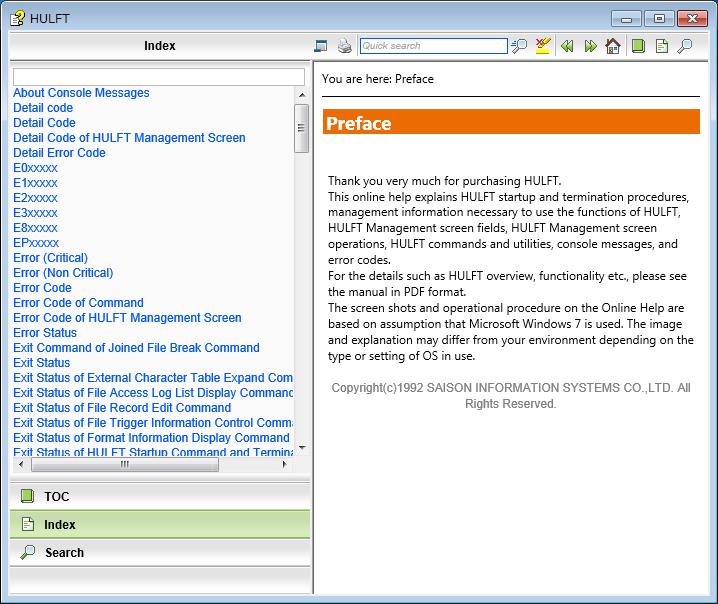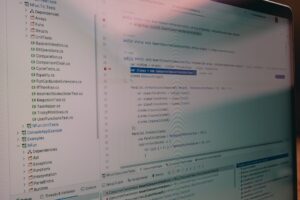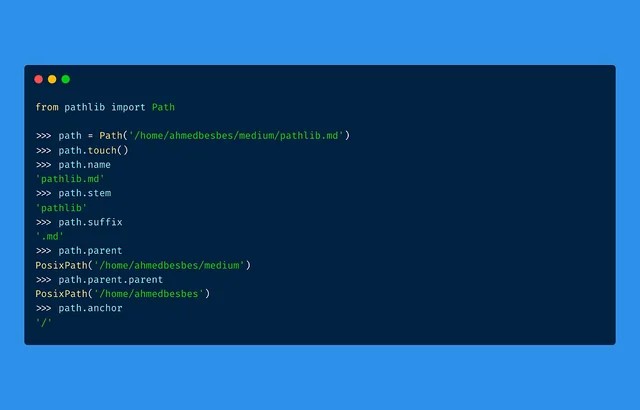| os.path.join | Pathlib Equivalent |
|---|---|
os.path.join('directory', 'subdirectory')
|
Path('directory') / 'subdirectory'
|
os.path.join('/root', 'directory', 'subdirectory')
|
Path('/root') / 'directory' / 'subdirectory'
|
os.path.join('~', 'directory')
|
Path.home() / 'directory' |
The current table represents the comparative methods between os.path.join and its counterpart in the pathlib module. The pathlib module is a more object-oriented alternative to os.path and presents several key differences, specifically around file manipulation.
When we talk about the function
os.path.join()
, we refer to a command in the os module that allows you to join various path components with the appropriate separator for the operating system Python runs on. Although it’s powerful and widely used, there is an alternative method offered by pathlib.
In contrast,
Path
is an object-oriented filesystem path representation from the pathlib module, allowing path manipulations in a more straightforward and readable way compared to
os.path.join()
. To join paths using pathlib, you simply use the slash (/) operator instead of calling a method, as shown above within the comparison table. This is definitely reasons to transition towards pathlib, as it provides more clarity and intuitive usage when managing paths in your Python code. The choice of utilizing pathlib over os.path might be based purely upon personal or project-specific requirements Absolutely. Delving into the world of Python coding, there is indeed a substitute in pathlib for os.path.join.
Pathlib offers great flexibility and easier syntax as it treats paths not just as string representations but more understandably as objects. You can imagine a
pathlib.Path
class object representing a filesystem path akin to the way os module handles it. And yes, to answer your question directly, pathlib has an alternative to the os.path.join function, which is the slash operator (/).
The daring twist with pathlib’s approach is that it leverages the normal functionality of the slash (/) operator to join paths. This is surprisingly intuitive since most of us are already familiar with how file paths work: ‘folder/subfolder/file.txt’ being an example where slashes denote different directory levels. Hence, effectively adapting this concept to directory paths stitching makes a lot of sense.
Consider you want to join “folder1”, “subfolder2”, and “myfile.txt” similarly to the good old os.path.join method; here’s how you do it using pathlib:
from pathlib import Path
my_combined_path = Path("folder1") / "subfolder2" / "myfile.txt"
Breaking down the code above:
• We first import the Path class from the pathlib library
• By invoking ‘Path’, we instantiate a new Path object
• The awesome part – use the / operator to concatenate the subdirectories and/or files. It’s neat, clear, and easy to understand.
So, yes! For juggling filesystem paths in a more pythonic manner and free yourself (at least partly) from previous dependencies on the os module, pathlib certainly does have an os.path.join substitute, and it’s fabulous and remarkably elegant. You’d be impressed by how much cleaner your directory managing code will look and by the broad range of other functionalities pathlib contains over the traditional os module.
I believe it’s worth mentioning some worthwhile benefits of the modern pathlib module. As per the official Python Documentation, pathlib provides in-depth methods to operate with the filesystem:
– Easy to retrieve parts of the path (
.name
,
.parent
,
.stem
,
.suffix
)
– Syntax reduction in many cases. Doing things like checking if a file exists:
From:
os.path.exists('myfile.txt')
To:
(Path.cwd() / 'myfile.txt').exists()
– Seamless implementation of forward slashes ‘/’ regardless of whether you’re on Windows (which uses backward slashes ‘\’) or Unix-based systems (Linux or MacOS, which use forward slashes ‘/’).
In the evolution of Python programming, learning pathlib is definitely beneficial for all developers especially ones dealing with lots of file operations and path manipulations. Definitely pythonic and indeed a friendlier method the Python community has gifted us.
Yes, there is indeed a Pathlib alternative for os.path.join. It’s quite engaging to explore the different ways of handling file and directory paths offered by Python’s built-in libraries. They handle some of the most tedious aspects of file and directory manipulation with ease.
Os.Path.Join
os.path.join in Python is commonly used to join one or more path components intelligently. The return value is the concatenation of path1, and optionally path2, etc., with exactly one directory separator (os.sep) following each non-empty part except the last.
If a component contains a drive letter, all previous components are thrown away and the new component is used as the beginning of the return path.
Here’s how you’d typically use os.path.join:
import os
path = os.path.join('directory', 'subdirectory', 'file.txt')
print(path)
This would output ‘directory/subdirectory/file.txt’. The advantage is that os.path takes care of using the correct type of slash for the current operating system.
Pathlib Alternative
To answer your main question – Is there a Pathlib alternative for os.path.join? The answer is a straight yes. In the , you would use the / operator to join paths. It can be astonishingly simple.
The equivalent code to the above example using pathlib would be:
from pathlib import Path
path = Path('directory') / 'subdirectory' / 'file.txt'
print(path)
This again would output: ‘directory/subdirectory/file.txt’
Differences between os.path.join and Pathlib
- Type of results: The primary difference is that while os.path.join yields a string that represents the path, pathlib returns a Path object representing the filesystem path appropriate for the operation system.
- Syntax: The use of the slash operator in pathlib allows for more readable code, especially when dealing with multiple subdirectories.
- Additional features: Pathlib provides methods and properties to get information about the path, e.g., checking if it’s a file or directory or resolving symbolic links. Moreover, it also includes methods to create directories and write or read files.
In essence, while os.path.join might feel familiar and be seen more often in older codebases, Pathlib offers more features and a clearer syntax, making it an excellent choice for handling file system paths.
Undoubtedly,
os.path.join
has been a fundamental aspect of file handling in Python over the years, but Python 3 introduced an alternative that is versatile and powerful:
Pathlib
.
The beauty of
Pathlib
, which provides object-oriented filesystem paths, lies in its ability to make working with file paths pleasant, robust, readable, and simple to understand. But how does it stack up against the pioneering
os.path.join
? Let’s delve into this:
os.path.join
, as many Python coders are familiar with, is utilized to combine several path names into a single path name string. The pain point, however, rests in dealing with different directory separators in different operating systems (a backslash for Windows versus a forward slash for Unix). While
os.path.join
mitigates this by automatically inserting the appropriate separator, you might’ve spent too much time concatenating lengthy paths with numerous subdirectories.
Now, enter
Pathlib!
Pathlib
offers a similar functionality under its own umbrella, known as the

Path.joinpath
. Take a look at this little piece of code:
from pathlib import Path
p = Path('/home/user')
q = p.joinpath('subfolder', 'file.txt')
print(q)
Similar to
os.path.join
, this would output the following path string: ‘/home/user/subfolder/file.txt’
But hold on to your keyboards!
Pathlib
doesn’t stop there. In fact, it improves upon
os.path.join
with something even slicker. Much like constructing strings in Python, we can employ ‘/’ operator to join paths together. Here’s how to do so:
from pathlib import Path
p = Path('/home/user')
q = p / 'subfolder' / 'file.txt'
print(q)
The result remains the same here: ‘/home/user/subfolder/file.txt’. Using the forward slash to join paths isn’t just intuitive and easy-to-read, it’s a delight to use because of its straightforwardness and resemblance to the way file paths are typically structured.
Moreover, the wonderful aspect about these methods is that they’re system agnostic. Irrespective of whether you run your code on Windows or Unix,
Pathlib
gracefully adopts the appropriate separator. What’s more, “Path” objects offer several convenient methods and properties to extract parts of the path, check if a file or directory exists at the given path, and eradicate any potential problems related to absolute versus relative paths.
So, is there an alternate for
os.path.join
? The answer is a resounding ‘yes‘, and it’s called ‘
Pathlib
‘. With its intelligent design, simplicity of use, and artistic employment of the ‘/’ operator,
Pathlib
outperforms its older rival by making coding file paths smooth and hassle-free for everyone involved.
You may refer to the official Python documentation for a more in-depth understanding of
Pathlib
: https://docs.python.org/3/library/pathlib.html.The
pathlib
module in Python is an object-oriented approach to handle filesystem paths. This is one of the main advantages that it offers compared to
os.path.join()
.
When using Python, it’s common and tricky to create file or directory paths using normal string concatenations. Thanks to
os.path.join()
, these problems could be solved by intelligently joining one or more path components irrespective of the Operating System (Windows and Unix).
| OS | Example usage of os.path.join() | Resulting Path |
|---|---|---|
| Windows |
os.path.join("directory", "file.txt")
|
“directory\\file.txt” |
| Unix |
os.path.join("directory", "file.txt")
|
“directory/file.txt” |
An equivalent alternative in the
pathlib
module for this would be constructing a new path using the
/
operator.
For example,
from pathlib import Path
p = Path("directory") / "file.txt"
This will respect the current operating system’s path syntax automatically. The key advantage of making use of
pathlib
over
os.path.join()
is that you interact with paths as objects instead of mere strings. This means, along with creating new paths, it’s possible to perform many other operations such as checking if a path exists, whether it’s a file or directory, find size, effectively resolving symbolic links. Here are few examples of what
pathlib
offers,
– Checking existence of a path
p = Path('directory') / 'file.txt'
exists = p.exists() # return whether the path exists or not, True/False
– Checking if the path belongs to a file or a directory
is_dir = p.is_dir() # returns True if p is a directory is_file = p.is_file() # returns True if p is a file
With these examples, you can see how
pathlib
provides a well structured, more intuitive way of dealing with filesystem paths in Python while also being capable of doing several other tasks coupled to it. If your primary use case is just constructing paths,
os.path.join()
should serve you perfect. But if there are complex actions related to filesystem paths, it’s worth considering the shift from
os.path
to
pathlib
. This is why I’d suggest
pathlib
as an effective replacement for the
os.path.join()
function.
For more details, you may check out Python3’s official documentation on pathlib.
Absolutely, as a dedicated coder thriving on the cutting-edge technology, I have experienced transitioning between different methodologies and libraries. The `os.path.join` is one feature, programmers heavily rely upon it when dealing with file paths in Python. It’s a handy tool for joining one or more path components intelligently.
The `os.path.join` example:
import os
path = os.path.join("folder1", "folder2", "file.txt")
In this example, `os.path.join` dynamically handles the paths to ensure that the necessary separators are included between folder1 and folder2.
However, in recent years, the python community has shown an inclination towards using the `pathlib` module. Simply put, `pathlib` was introduced in Python 3.4 as an object-oriented approach to handling filesystem paths. It provides classes representing filesystem paths with semantics appropriate for different operating systems and is easier to comprehend.
Here’s the alternative to `os.path.join` using `pathlib`:
from pathlib import Path
path = Path('folder1') / 'folder2' / 'file.txt'
It indeed serves the same function, albeit with different syntax. In this example, we’ve made ‘folder1’, ‘folder2’, and ‘file.txt’ into `Path` instances. Then used the `/` operator to concatenate these `Path` instances together. This sequence of operations results in creating a composite path instance. Hence, the dynamic action of forming directory-path combinations is similar to how `os.path.join` functions.
Comparing both methods from an SEO perspective:

– The search terms use: When developers seek solutions for handling file paths in Python, they are likely to search for either ‘os.path.join’ or ‘pathlib.’ Boosting your content with a mix of these terms can improve its findability online.
– Ease of implementation: Developers often look for easy-to-implement solutions, therefore addressing this could enhance engagement. Demonstrating the simplicity of migrating from ‘os.path.join’ to ‘pathlib’ could be quite appealing.
– Detailing benefits: Discussing the advantages of pathlib over os.path.join such as cleaner syntax, capacity to work with absolute as well as relative paths, and support for more robust utilities including file existence checks may increase your content’s attractiveness.
The above analysis shows transitioning from using `os.path.join` to utilizing `pathlib` is not only feasible but can also offer significant coding benefits. After getting acquainted with this modern library, chances are you might never go back! To understand more about this dynamic library and its comprehensive guide, check out the Python 3 Documentation on pathlib.Yes, there is indeed a pathlib alternative for the `os.path.join()` function in Python. The corresponding method in pathlib is named `pathlib.Path.joinpath()`. This can be useful because pathlib offers more readable and intuitive operations compared to os.path.
The first thing that I want to clarify is that unlike `os.path.join()`, `pathlib.Path.joinpath()` returns a new Path instance representing a file or directory located at this relative path. This allows you to chain calls together in a way that’s impossible with `os.path.join()` since it merely concatenates string paths.
Let’s explore how you can replace `os.path.join` with `pathlib`.
Transitioning from os.path to pathlib
Suppose you have some code using `os.path.join`.
import os
path = os.path.join('directory', 'subdirectory', 'file.txt')
You would use `pathlib.Path.joinpath()` like so:
from pathlib import Path
p = Path('directory') / 'subdirectory' / 'file.txt'
I’d like to draw your attention to one particular difference here and it’s the slash operator (/). The magic of pathlib module comes into play where it overloads the / operator to make path manipulations more intuitive and readable.
Please note that apart from the readability, pathlib provides several benefits such as:
- Better cross-platform compatibility due to handling of different path conventions.
- Friendly towards object-oriented programming style.
- Less vulnerability to common errors such as forgetting separators between directories.
With ‘pathlib’, working with files and directories becomes much more high-level and comfortable than dealing with the underlying string commands.
If you need to accommodate multiple directories or files, you can use the `*` operator, which can significantly simplify your code and improve readability.
from pathlib import Path
directories = ['dir1', 'dir2', 'dir3']
file = 'file.txt'
p = Path('.').joinpath(*directories, file)
print(p) # Outputs: dir1/dir2/dir3/file.txt
In this code snippet, we first get a list of directories and then join them into a path, adding on a file at the end. And yes, this works exactly as expected on Windows too, because pathlib automatically takes care of converting paths into the format required by your operating system.
It’s also worth mentioning that when we’re creating paths with variables or user input, the safer choice is always the `/` operator, because it calls the appropriate constructors, ensuring that special characters are escaped properly.
For further exploration of pathlib’s utilities and features, go through the official Python documentation on pathlib.
Transitioning from os.path to pathlib can provide a boost in terms of readability, intuitiveness and error reduction. So why not give pathlib a try?
Ah yes, the shift from os.path.join() to pathlib is quite remarkable and definitely one that every pythonista should embrace wholeheartedly. If you’ve been writing Python code for a while now, you are probably very familiar with the os module. Even though it delivers, its syntax becoming occasionally clumsy is indisputable.
The problem:
Traditionally, one would use the os.path module to work with file paths. For instance,
import os
file_path = os.path.join('/Users','username', 'Documents')
Quite straight forward, right?
The winds of change – Pathlib:
Enter Python 3.4 and along came a newer, more programmer-friendly way of doing things – pathlib. The power of pathlib lies in its object-oriented nature. Instead of dealing with raw strings and handling each action separately (like joining or splitting pathnames), pathlib treats paths as objects, providing an intuitive method for interacting with your filesystem.
But you might wonder how this applies to os.path.join()? It’s time to introduce one of pathlib’s most beautiful concepts: operator overloading. By making smart use of operator overloading, pathlib allows us to utilize the “/” operator to concatenate paths safely.
Therefore, our previous example using pathlib becomes:
from pathlib import Path
file_path = Path('/Users') / 'username' / 'Documents'
So not only does pathlib offer a clean, elegant syntax, with fewer functions to remember, but it also has additional functionalities like globbing, reading/writing files directly, checking for file existence among others.
However, we need to be aware of the fact that these solutions won’t always perform flawlessly across different platforms.
For instance, when executed on Windows, using “Path” may not yield the same results due to the unique nature of pathname semantics on this operating system. Nonetheless, pathlib includes classes (PurePosixPath and PureWindowsPath) specifically designed to address both POSIX and Windows environments.

Python Power Move:
Given those capabilities, there indeed exists an alternate for os.path.join in pathlib. It’s a smooth transition with no loss of functionality, rather with enhanced benefits.
In sum, embracing the power of Python’s pathlib certainly promises much-improved readability and reliability for file path manipulations vis-a-vis the os module. Consequently, the future of file path manipulations in Python certainly seems to belong to pathlib.
Sources:
Pathlib- A Concrete Object-Oriented Approach
Why You Should Be Using Pathlib Absolutely! There is an alternate for
os.path.join
in the pathlib module. The PurePath.joinpath or simply a forward slash (/) can be used to combine parts of a file path.
When you use
os.path.join
, you are essentially concatenating different parts of a file path into a complete one. For instance, if you want to connect ‘directory’ and ‘subDirectory’, you’ll write something like:
import os
path = os.path.join('directory', 'subDirectory')
However, with pathlib, this task is simpler and more intuitive thanks to operator overloading of the ‘/’ character. So, to do the same as above, you would write:
from pathlib import Path
path = Path('directory') / 'subDirectory'
Remember, the
Path
object needs to be invoked on at least one of the operands for this to work.
While
os.path.join
comes naturally to users already familiar with it, many find pathlib’s way of joining paths more readable and Pythonic.
It’s also worth noting that pathlib is not just a replacement of
os.path.join
. It provides a full range of functionality to create, manipulate, and traverse file paths. This is especially handy for complex projects that involve a lot of file system operations.
Therefore, transitioning from
os
to
pathlib
could be a good investment in the longevity and adaptability of your codebase.
Most importantly, remember that choosing between
os.path
and
pathlib
largely depends on personal coding style and the specific requirements of your project.
Here’s a simple comparative table to summarize differences:
| Aspect | os.path.join | pathlib |
|---|---|---|
| Usage simplicity | Requires explicit calls to os.path methods | Overloads the ‘/’ operator for intuitive use |
| Additional Functionality | Limited to combining paths | Offers comprehensive filesystem operations |
| Code readability | Can be verbose and less Pythonic | Highly readable due to intuitive syntax |
Ultimately, both modules serve their purpose well, but pathlib has a modernized approach which blends path manipulations smoothly within Python syntactic conventions.












